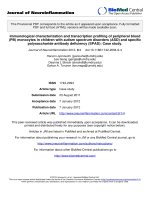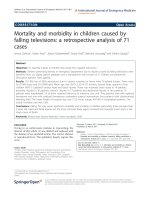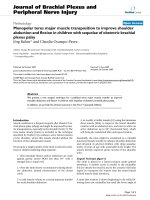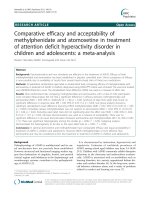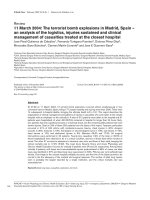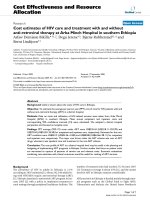Clinical and paraclinical charateristic of pulmonary agenesis and hypoplasia in children treated at National Pediatric Hospital
Bạn đang xem bản rút gọn của tài liệu. Xem và tải ngay bản đầy đủ của tài liệu tại đây (104.84 KB, 5 trang )
Journal of military pharmaco-medicine no4-2018
CLINICAL AND PARACLINICAL CHARATERISTICS OF
PULMONARY AGENESIS AND HYPOPLASIA IN CHILDREN
TREATED AT NATIONAL PEDIATRIC HOSPITAL
Nguyen Thi Mai Hoan*; Dao Minh Tuan*; Mai Xuan Khan**
SUMMARY
Objectives: To provide better understanding of pulmonary agenesis and hypoplasia.
Subjects and methods: A retrospective and prospective descriptive study on all patients with
pulmonary agenesis and hypoplasia admitted to Respiratory Department, National Pediatric
Hospital from January 2011 to December 2016. Results and conclusion: In the 6-year-period
study, there were a total of 21 patients with pulmonary agenesis and hypoplasia (0.079%)
admitted to Respiratory Department. 14 of them had pulmonary agenesis and 6 had pulmonary
hypoplasia. 80% of patients were younger than 6 months old, the earliest diagnosis was during
the fetal period whereas the latest was a 12-year-old patient and high female-to-male ratio. The
most common signs and symptoms were coughing, wheezing, dyspnea, decreased vesicular
breath sound and recurrent pneumonia. Radiologic imaging: Hemithorax white-out, unilateral
pulmonary artery agenesis or pulmonary artery atresia.
* Keywords: Pulmonary agenesis; Pulmonary hypoplasia; Children.
INTRODUCTION
Pulmonary agenesis and hypoplasia
are characterised by the incomplete
development of airways and lung
parenchyma.
The severity of this disorder depends
on the stages of lung development during
the fetal period and the presence of other
associated anatomical abnormalites.
Pulmonary agenesis and hypoplasia
occured in the embryonic stage (about
4 weeks of gestational age) when the
'primitive' lung is formed. The reason is
unknown but genetic factors, environment
and chemicals might be the causes [6].
The most typical characteristics consist
of the incomplete development of the lung
parenchyma, which still has bronchial
stump or carina as in aplasia and is
usually diagnosed at 23 to 30 weeks of
gestational age.
The severity of the disease depends
on associated congenital anomalies (50%
with cardiovascular anomalies), patients
with right-sided agenesis/hypoplasia have
longer life expectancy than those with left
sided [1].
Abdominal aortic hemorrhage at
4 months of pregnancy is related to
pulmonary agenesis/hypoplasia.
* National Pediatic Hospital
** 103 Military Hospital
Corresponding author: Nguyen Thi Mai Hoan ()
Date received: 09/01/2018
Date accepted: 26/03/2018
180
Journal of military pharmaco-medicine no4-2018
Since it is such a rare condition with
the rate of 1/10,000 - 15,000 live births
[1], we conducted this research to give
better understanding of pulmonary agenesis
and hypoplasia.
agenesis and 6 cases of pulmonary
hypoplasia, accounting for 0.79% children
admitted to Respiratory Dept. According
to Conway K et al, pulmonary agenesis
rate is 1/100,000.
Objectives: To assess the rate of
pulmonary agenesis and hypoplasia and
to present clinical manifestations, radiologic
imaging and laboratory findings of these
diseases.
SUBJECTS AND METHOD
1. Subjects.
All patients with pulmonary agenesis
and hypoplasia admitted to Respiratory
Department, National Pediatric Hospital
from January 2011 to December 2016.
2. Method.
- Research design: A retrospective and
prospective descriptive study.
- Technique: Review the medical records
of patients with the definitive diagnosis of
pulmonary agenesis/hypoplasia at discharge
and also study the admitted patients,
those with definitive of pulmonary
agenesis/hypoplasia during treatment.
Figure 1: Sex distribution.
In terms of sex, female/male ratio
15/7 = 2 (this means that females
outnumbered males but as reported by
previous researches, there was no gender
difference [2]).
Table 1: Characteristics of sex in both
pulmonary agenesis/hypoplasia.
Pulmonary
agenesis
Pulmonary
hypoplasia
n
%
n
%
Male
5
23.81
2
9.52
33.33
Female
10
47.62
4
19.05
66.67
15
71.43
6
28.57
100
Sex
- Sampling criteria: Patients with
pulmonary agenesis/hypoplasia.
- Diagnostic criteria:
+ Clinical manifestations: Wheezing,
postnatal respiratory failure, prolonged
cough, recurrent pneumonia.
+ Radiologic imaging: Chest radiograph,
thoracic CT-scan and echocardiography.
RESULTS AND DISCUSSION
1. Age, gender and obstetric history
of subjects.
In this research, there were 21 cases
in total, with 15 cases of pulmonary
Total
Total
In terms of age, 80% of subjects were
younger than 6 months old, the earliest
diagnosis was at fetal period (6 months),
the latest was 12 years old; similar to the
previous research [1].
Take history into consideration,
amongst the patients with pulmonary
agenesis and hypoplasia, there were no
181
Journal of military pharmaco-medicine no4-2018
notorious obstetric history: 9
cases accounted for 42.85%,
with congenital abnormalites
congenital heart disease,
preterm
3 cases
(2 with
1 with
congenital gastrointestinal anomaly),
3 cases with oligohydramnios, 1 case
whose mother had flu during her first
trimester [5].
2. Rates of pulmonary agenesis and hypoplasia.
Table 2:
Position
Pulmonary agenesis
Pulmonary hypoplasia
Total
n
%
n
%
Right
10
47.62
3
14.28
61.9
Left
5
23.81
3
14.29
38.1
15
71.43
6
28.57
100
Total
There were 15 cases of pulmonary agenesis (71.43%) and 6 cases of pulmonary
hypoplasia (28.57%) with the prevalence of the right-side, consistent with the
previous research.
Figure 2: The ratio of right-sided to left-sided.
Pulmonary agenesis/hypoplasia was seen in 65% of the patients, in agreement with
previous research.
3. Clinical and paraclinical findings of pulmonary agenesis and hypoplasia.
Table 3:
Symptoms
Pulmonary agenesis
Pulmonary hypoplasia
Total
n
%
n
%
n
%
Cough
15
71.43
6
28.57
20
100
Fever
3
14.29
1
4.76
5
19.05
Wheezing
9
42.86
6
28.57
15
71.43
Stridor
5
23.81
1
4.76
8
28.57
182
Journal of military pharmaco-medicine no4-2018
Dyspnea
15
71.43
6
28.57
20
100
Retractions
10
47.62
6
28.57
16
76.19
Cyanosis
5
23.81
2
9.52
7
33.33
Decresead esicular sound
14
66.67
6
28.57
20
95.24
Wheezes
6
28.57
2
9.52
8
38.09
Rhonchi
7
33.33
4
19.05
11
52.38
Crackles
12
57.14
6
28.57
18
85.71
* Clinical manifestations:
Symptoms: cough (100%), wheezing (71.43%), stridor (28.57%), dyspnea (100%)
retractions (76.19%), cyanosis (33.33%) often seen in children younger than 3 months
old, mainly in those younger than 6 months old, rhonchi (52.38%), crackles (85.71%).
The most frequent reason for admission in children younger than 6 months of age
was respiratory failure, contradictory to airway malformation which are wheezing and
stridor.
Table 4: Laboratory findings and radiologic imaging.
Pulmonary agenesis
Pulmonary hypoplasia
Total
Symptom
n
%
n
%
n
%
Inflammatory response
7
33.33
3
14.29
10
47.62
Anemia
7
33.33
5
23.81
12
57.14
Hemithorax white-out
15
71.43
6
28.57
20
100
Pulmonary agenesis/atresia
15
71.43
6
28.57
20
100
Inflammatory response: WBC > 10 G/l and CRP > 10 mg/L
More than 80% of subjects were admitted to the hospital with symptoms of cough,
dyspnea and crackles.
DISCUSSION
Pulmonary agenesis and hypoplasia
are congenital disease defined as
incomplete development of airways and
parenchyma. The ratio is 9 to 11 per
100,000 [5].
80% of subjects were early diagnosed
before 6 months of age, the same as
other researches [3, 6]. There were 3 cases
with associated congenital anomalies,
accounting for 14.29%, different from other
researches [2, 4] which was up to 50%.
According to previous researches [2,
5], male-female ratio is balance but in this
research it shows a prevalence in female
more than in male.
- Clinical finding is early respiratory
failure and can cause neonatal death,
others might have recurrent respiratory
infections [1].
183
Journal of military pharmaco-medicine no4-2018
- Radiologic imaging: hemithorax
white-out, pulmonary artery agenesis or
atresia. Echocardiography and angiography
support the diagnosis of pulmonary
agenesis and hypoplasia [3].
CONCLUSION
Pulmonary agenesis/hypoplasia is a
rare condition with the incomplete
development of lung parenchyma during
the fetal period, usually associated with
congenital heart and gastrointestinal
defects. We reported only 21 cases
during 6 year period study, accounting for
0.79% patients admitted to Respiratory
Department in National Pediatric Hospital.
The disease is more prevalent in female,
double the number as found.
The disease usually manifests early
and can cause neonatal death. The most
common signs and symptoms are
coughing, wheezing, dyspnea and
retractions. However, sometimes the
disease is accidentally discovered due to
respiratory infection, decreased vesicular
sound. The radiologic imaging of the disease
in X-ray and CT-scan are hemithorax
white-out, pulmonary agenesis or atresia.
184
REFERENCES
1. Berger R.M, Beghetti M, Humpl T,
Raskob G.E, Ivy D.D, Jing Z.C et al. Clinical
features of paediatric pulmonary hypertension:
A registry study. Lancet. 2012, Feb 11, 379
(9815), pp.537-546.
2. Conway K, Gibson R.L et al. Pulmonary
agenesis: Expansion of the VCFS phenotype.
Am J Med Genet. 2002, 113, pp.89-92.
3. Hofmann A.D, Friedmacher F, Takahashi
T, Gosemann J.H, Puri P. Increased
pulmonary vascular expression of receptor of
advanced glycation end products (RAGE) in
experimental congenital diaphragmatic hernia.
Journal of Pediatric Surgery. 2015, 50,
pp.746-749.
4. Laudy J.A.M, Wladimiroff J.W. The fetal
lung 2: Pulmonary hypoplasia. Ultrasound
Obstet Gynecol. 2000, 16, pp.482-494.
5. Triebwaser J.E, Treadwell M.C. Prenatal
prediction of pulmonary hypoplasia. Seminars
in Fetal and Neontal Medicine. 2017, pp.1-5.
6. Taussig. Lynn, Landau Louis. Pediatric
Respiratory Medicine, LWW. 2008.
7. Winn H.N, Chen M, Amon, E, Leet T.L,
Shumway J.B et al. Neonatal pulmonary
hypoplasia and perinatal mortality in patient
with midtrimester rupture of amniotic
membranes - A critical analysis. American
Journal of Obstetrics and Gynecology. 2000,
182 (6), pp.1638-1644.

